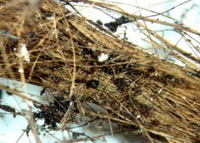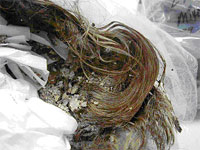Hair Today, Gone Tomorrow:
The Conservation and Analysis of Philip Calvert’s Hair
Even after the recovery, analysis and conservation treatment of archaeological materials, research questions remain dependent on what is discovered during excavation. Some samples of materials are purposefully left untreated, so that future scientific study of the materials remains possible when new equipment becomes available, or when questions are asked. The third and largest lead coffin was a well-crafted, six-sided box with cast iron handles at the head and foot. Within the metal coffin was a cedar coffin. The remains of the adult male it contained were in a bizarre state. The bones below the man’s waist were still in excellent condition, but nearly all those of his upper body had been mysteriously transformed into white crystals—perhaps the result of an unsuccessful attempt at embalming. Little of his skull survived as bone, but surprisingly, his shoulder length, auburn hair was perfectly preserved.

Detail of Philip Calvert’s hair
Due to the limited amount of research available on the conservation of human hair, and the extreme fragility of this unique find, the primary goal was to stabilize the hair until further research, analysis and conservation could be undertaken. The hair was examined and its condition assessed, in order to gain a better knowledge on it’s overall fragility and state of preservation. The hair is currently stable, with little or no deterioration since its discovery in 1992. Some small samples of hair have been detached and separated from the main section of the hair. The hair is slightly dry to the touch, but remains free of any bacterial or fungal growth. The hair is physically intact, due to the limited handling of the artifact over the past five years.
In 1992, The Armed Forces Pathology Research Institute performed Neutron Activation Analysis on a sample of the hair from both the woman and man’s coffin. A large amount of iron was found in the auburn hair from the man’s coffin, possibly indicative of the red color. Other interesting data include the discovery of silver ions in the back of the woman’s hair, possibly indicating that silver hair pins or fasteners were worn repeatedly in this same area of the hair. But the question remained, why is the hair so red? And what causes this phenomenon to occur post-mortem: other samples of archaeological hair evidence the same vivid color?

Philip Calverts hair with archival packaging.
And what causes this phenomenon to occur post-mortem: other samples of archaeological hair evidence the same vivid color?
Research shows that red hair is linked to its iron content. It is probably a chemical reaction — iron mineral salts which have replaced part of the hair protein, something that has been seen in other archaeological specimens. The question of how the iron got into the hair remains. Whether the person was a natural redhead or wheher the red hair a by-product of practices unknown has yet to be determined.
Analysis of the hair is on-going and directed at learning whether degradation occurred before or after burial. The answer may be related to hair practices, treatments of the hair, and diet, and will shed some light on what the hair went through while it was in a living state. Baseline data established during this study will be useful in monitoring any degradation of the sample that may occur during storage.


